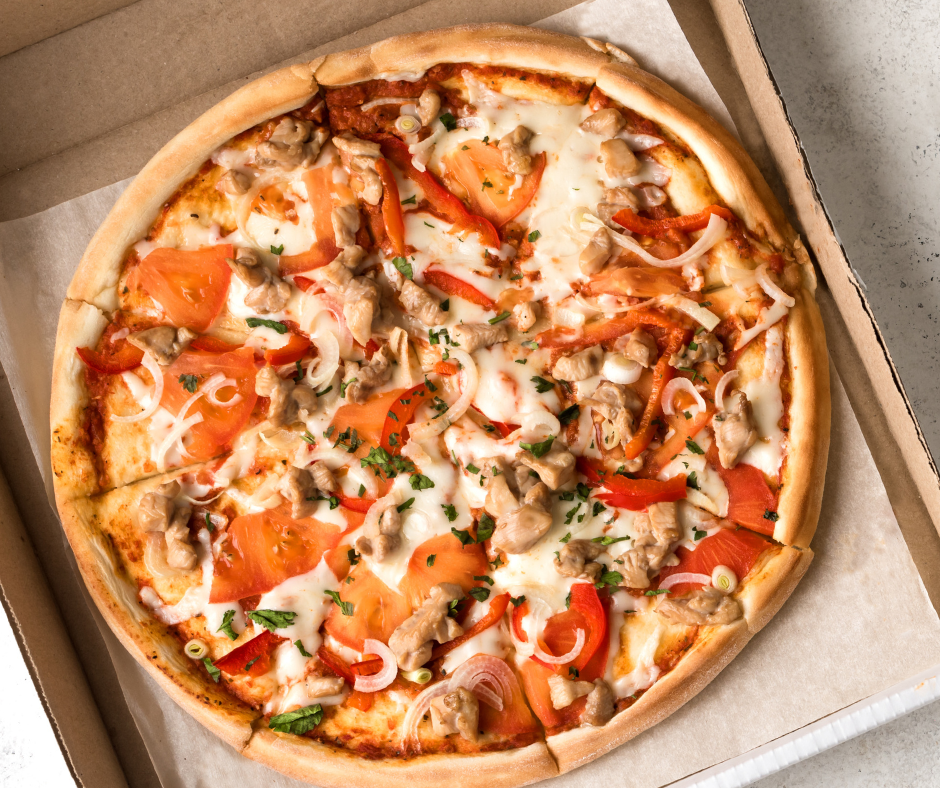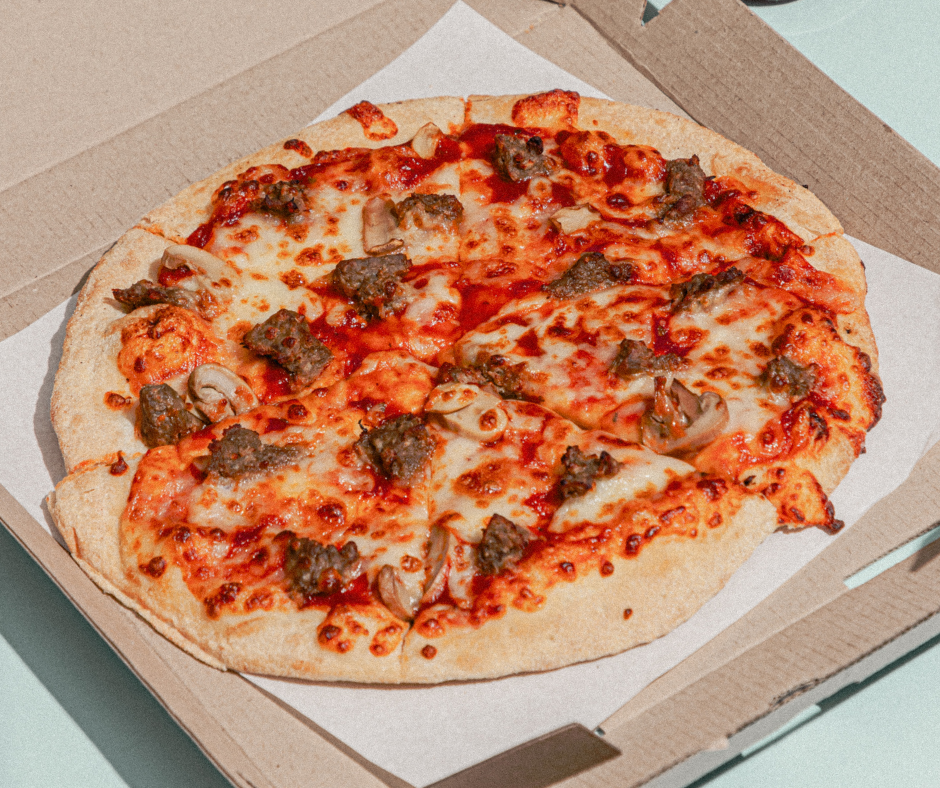Introduction
Pizza boxes are common in the food industry, used to transport our favorite cheesy delight. However, the question arises: Can you put a pizza box in the oven? In this blog post, we will delve into the potential hazards of putting a pizza box in the oven and discuss safe practices for reheating pizza.
Why Putting A Pizza Box In The Oven Is A Concern
It is important to understand that putting a pizza box in the oven poses a significant safety concern. Despite claims made by some manufacturers, pizza boxes are not designed to be oven-safe. The primary reason for this is the risk of fire. Cardboard and paper, which pizza boxes are made of, can easily catch fire at temperatures around 400 degrees Fahrenheit. Even when low oven temperatures are set, the risk of ignition remains high.
Additionally, foreign materials like metals and plastics that may come into contact with the heat source in the oven can increase the likelihood of a fire hazard. These materials can easily ignite and cause a potentially dangerous situation in the kitchen.
Can You Put a Pizza Box in the Oven? Understanding Oven Safety And Pizza Box Materials
To ensure the safety of your kitchen and minimize the risk of fire hazards, it is crucial to understand the materials used in pizza box construction. Pizza boxes are typically made from robust and sturdy corrugated cardboard, which provides insulation and protects the pizza during transportation. However, it is important to note that pizza boxes can vary in composition and thickness, depending on the supplier and specific restaurant or pizzeria requirements.
While some manufacturers claim their pizza boxes can withstand the heat of an oven, it is generally not recommended. The high temperatures reached in an oven can exceed the safe temperature range for cardboard and inks used in printing. This can lead to the release of hazardous chemicals into food, posing health risks to consumers.
To ensure oven safety and avoid potential hazards, transferring your pizza to an oven-safe dish or baking sheet before reheating is best. This will allow you to safely warm up your pizza without risking the release of harmful substances or the ignition of the pizza box.
In conclusion, to answer ‘Can You Put a Pizza Box in the Oven?’, putting a pizza box in the oven is not advisable. The myth suggesting otherwise can lead to toxic fumes, fire hazards, and potential harm to individuals. It is crucial to prioritize safety in the kitchen and follow recommended practices for reheating pizza. Transferring your pizza to an oven-safe dish allows you to enjoy your favorite cheesy delight without compromising your well-being.

The Risks Of Putting A Pizza Box In The Oven
Fire Hazard And Safety Concerns
Fire risk is one of the main hazards of putting a pizza box in the oven. Pizza boxes are typically made of cardboard, which is flammable. When exposed to high temperatures, the thin material can easily catch fire, potentially causing significant damage to your kitchen or even putting your entire house at risk. The direct contact between the cardboard and the heating elements in the oven can create a dangerous situation.
To ensure the safety of your kitchen and avoid fire hazards, it is crucial never to put a pizza box in the oven. Instead, transfer your pizza to an oven-safe dish or baking sheet before reheating. This simple action can help prevent the cardboard’s ignition and minimize the fire risk.
Potential Health Risks From Chemical Exposure
In addition to the fire hazard, putting a pizza box in the oven can pose health risks due to chemical exposure. Pizza boxes are often printed with ink dyes and may contain stickers that can release harmful chemicals when exposed to high heat. These chemicals can contaminate your food, potentially causing adverse health effects.
To avoid potential chemical contamination, transferring your pizza to an oven-safe dish or baking sheet before reheating is advisable. Doing so can protect yourself and your family from potential health risks associated with releasing harmful chemicals from the pizza box materials.
By understanding the risks and taking necessary precautions, you can safely reheat your pizza without putting yourself or your home in danger. Always prioritize safety in the kitchen and follow recommended practices to prevent fire hazards and chemical exposure.
Best Practices For Reheating Pizza
To safely reheat your pizza, follow these best practices:
- Preheat your oven: Set your oven to a low or medium temperature, typically around 350-400 degrees Fahrenheit.
- Transfer pizza to an oven-safe dish: Place your pizza slices on a baking sheet or an oven-safe dish. This will help ensure even reheating and prevent the potential hazards of putting the pizza box in the oven.
- Reheat briefly: Monitor your pizza closely while reheating and remove it from the oven as soon as it reaches the desired temperature. Overheating can lead to dry and unappetizing pizza.
- Enjoy your reheated pizza: Once it is heated, take it out of the oven and let it cool for a few minutes before enjoying it. This will prevent any potential burns and allow the flavors to settle.
Following these best practices allows you to enjoy a hot and delicious slice of pizza without compromising your safety or health.
The Role Of The Anti-grease Layer
When it comes to reheating pizza, many people wonder if putting the entire pizza box in the oven is safe. However, it’s important to understand the role of the anti-grease layer in pizza boxes and the potential consequences of heating the box with this layer.
Explanation Of The Anti-grease Layer And Its Purpose
The anti-grease layer is a coating applied to the bottom of pizza boxes, specifically the part that comes into contact with the pizza. Its primary purpose is to prevent oil or grease from the pizza from seeping through the box and creating a mess during delivery.
This layer typically comprises grease-resistant materials, such as wax or similar substances. It acts as a protective barrier, ensuring the pizza box remains intact and grease-free throughout delivery.
The Consequences Of Heating The Pizza Box With The Anti-grease Layer
However, when it comes to reheating the pizza, it’s crucial to avoid putting the entire pizza box in the oven. The high temperatures in the oven can cause the anti-grease layer to disintegrate or melt. This is a concerning issue because the chemicals used in this layer could potentially leach into the pizza itself.
The longer you leave your pizza in the oven and the higher the heat, the greater the risk of the box melting and releasing harmful chemicals. Even if the box doesn’t catch fire, contamination from paints, dyes, or anti-grease chemicals is still possible.
To ensure the safety of your food and to avoid ingesting any potentially harmful substances, it is recommended to transfer your pizza to an oven-safe dish or baking sheet before reheating. This simple step helps to prevent any chemical contamination and protects your health.
Furthermore, you can ensure the heat is evenly distributed by reheating the pizza without the box, resulting in a tastier and more satisfying slice. The box may trap moisture, leading to soggy crusts or uneven heating, which can impact the overall quality of the pizza.
In conclusion, while it may be tempting to put the entire pizza box in the oven for convenience, it’s important to consider the potential risks involved. The anti-grease layer on the box serves its purpose during delivery but can pose a danger when heated. To enjoy your reheated pizza safely and deliciously, always transfer it to an oven-safe dish and follow the recommended reheating practices. Taking these precautions allows you to indulge in a hot and tasty pizza without compromising your health or safety.

Alternatives To Putting The Whole Pizza Box In The Oven
Transferring Pizza Slices To A Heat-safe Container
Instead of putting the entire pizza box in the oven, transferring the pizza slices to a heat-safe container is a safer alternative. This can be a glass, metal, or ceramic dish that can withstand high temperatures. Doing so eliminates the risk of the anti-grease layer melting and potentially contaminating your food.
To transfer the pizza slices, remove them from the original pizza box and place them in the heat-safe container. For easy clean-up, you can line the container with aluminum foil or parchment paper. Make sure to leave some space between the slices to ensure even heating.
Using A Pizza Stone Or Baking Sheet To Reheat Pizza
Another effective method is to use a pizza stone or baking sheet to reheat pizza. These cooking surfaces are designed to distribute heat evenly, producing a crispy crust and evenly heated toppings.
To use a pizza stone, preheat it in the oven at the desired temperature. Once it’s hot, carefully place the pizza slices on the stone using a pizza peel or a spatula. Allow the pizza to heat for a few minutes until the crust is crispy and the toppings are heated.
A baking sheet can also do the job if you don’t have a pizza stone. Preheat the baking sheet in the oven, then transfer the pizza slices onto it. Place the baking sheet back in the oven and heat until the crust is crisp and the cheese is melted.
Both methods require monitoring to prevent the pizza from burning. Keep an eye on the slices and adjust the cooking time as needed.
In conclusion, it may be tempting to put the entire pizza box in the oven for convenience, but it is unsafe due to the potential risks associated with the anti-grease layer. Transferring the pizza slices to a heat-safe container or using a pizza stone/baking sheet can safely and effectively reheat your pizza. Remember always to prioritize safety and follow recommended reheating practices to enjoy a delicious slice of pizza.
Oven-safe Pizza Practices
Proper Temperature And Timing For Reheating Pizza
When it comes to reheating pizza in the oven, it’s important to ensure that you use the proper temperature and timing to avoid any safety hazards or compromising the quality of your food. The recommended temperature for reheating pizza is usually around 350 to 400 degrees Fahrenheit. This temperature allows for even heating and helps maintain the crust’s crispiness.
Timing is also crucial when reheating pizza. It’s best to reheat the pizza for 10 to 15 minutes or until the cheese is melted and the crust crispy. Keep a close eye on the pizza to prevent it from burning, as the exact timing may vary depending on the thickness of the crust and toppings.
Tips For Maintaining The Quality Of Reheated Pizza
To ensure that your reheated pizza is just as delicious as when fresh, it’s important to follow a few tips for maintaining its quality.
Firstly, avoid crowding the oven tray or baking sheet with too many pizza slices. Leaving space between each slice allows for better airflow, resulting in more even heating and a crispier crust.
Secondly, consider using a pizza stone or a baking sheet with holes to help prevent sogginess. These surfaces will help absorb any excess moisture and give the crust a desirable crunch.
Lastly, if you want to add extra crispiness to your reheated pizza, you can try briefly broiling it for a minute or two at the end of the reheating process. This will help to achieve a golden and crispy texture on the top of the pizza.
Following these oven-safe pizza practices allows you to enjoy a delicious and crispy reheated pizza without compromising safety or taste. Always prioritize safety, such as avoiding putting a pizza box in the oven, and follow the recommended methods for reheating pizza to ensure the best results. Happy reheating!

Conclusion
Now you should know the answer to ‘Can You Put a Pizza Box in the Oven?’. When it comes to reheating pizza, it’s important to understand the potential dangers of putting a pizza box in the oven. Fire hazards and chemical contamination are two significant risks associated with heating pizza boxes made of cardboard. To ensure the safety of your kitchen and home, avoiding using pizza boxes in the oven is best.
Instead, follow oven-safe pizza practices for reheating your leftover pizza. Set the oven temperature to around 350 to 400 degrees Fahrenheit for even heating and to maintain the crust’s crispiness. Timing is crucial, and it is recommended to heat the pizza for about 10 to 15 minutes or until the cheese is melted and the crust is crispy. Keep a close eye on the pizza to prevent burning.
To maintain the quality of reheated pizza, avoid crowding the oven tray or baking sheet with too many slices. Leave space between each slice for better airflow and a crispier crust. Consider using a pizza stone or a baking sheet with holes to prevent sogginess by absorbing excess moisture. For an extra crispy texture, you can briefly broil the pizza for a minute or two at the end of the reheating process.
Following these oven-safe pizza practices allows you to enjoy a delicious and crispy reheated pizza without compromising safety or taste. It is important to prioritize food safety and avoid putting a pizza box in the oven. Instead, transfer the pizza to an oven-safe baking dish or stone, or use a baking sheet to heat it evenly and safely.
In conclusion, while heating a pizza box may seem convenient, the potential dangers outweigh the convenience. Awareness of these risks and opting for safe and effective reheating methods is essential. Enjoy your leftovers and prioritize safety and food quality for a delicious pizza experience.
FAQ: Can You Put a Pizza Box in the Oven? Oven-Safe Pizza Practices
Q: Can You Put a Pizza Box in the oven to reheat pizza?
A: It is not recommended to put a pizza box in the oven to reheat pizza. Cardboard boxes can pose serious risks if exposed to high heat, such as catching fire or releasing harmful chemicals into the food.
Q: What are the dangers of putting a pizza box in the oven?
A: Putting a pizza box in the oven can result in various dangers. The high heat can cause the box to fire, posing a significant safety hazard. Additionally, the cardboard may contain unsavory chemicals that can be released into the food when heated.
Q: How can I safely reheat pizza without using a pizza box in the oven?
A: To safely reheat pizza without using a pizza box in the oven, follow these steps:
- Remove the pizza from its original box.
- Place the pizza on an oven-safe dish or tray at home.
- Line the dish with aluminum foil or parchment paper to reduce the risk of contamination and provide a protective barrier against direct heat.
- Place the dish with the pizza into the preheated oven.
Q: Are there alternatives to using a traditional oven for reheating pizza?
A: There are alternatives to using a traditional oven for reheating pizza. You can use a microwave or toaster oven as a convenient and efficient. However, ensure that you still place the pizza on an oven-safe dish or tray before reheating to reduce potential risks.
Q: What benefits to using an oven-safe dish or tray instead of a pizza box?
A: Using an oven-safe dish or tray has two advantages over using a pizza box:
- It eliminates the risk of chemical contamination from overheating paper or cardboard, making it safer to consume pizzas that have been stored in them.
- It helps lock in moisture, preventing the pizza crust from drying while reheating.
Q: Can I use parchment paper or aluminum foil to protect the pizza from direct heat in the oven?
A: Yes, both parchment paper and aluminum foil can be used as protective barriers against direct heat in the oven. They provide insulation that helps prevent the cardboard box from catching fire and makes reheating pizza safer.
Following these practices, you can safely reheat pizza without placing a cardboard box in the oven. It ensures that your food stays hot, delicious, and free from potential risks associated with the box.
Graham Bartlett, owner at Taco and Piña Mexican food, is all about bringing the authentic flavors of Mexico to your plate. With Graham Bartlett, you can tantalize your taste buds with mouthwatering tacos and delicious piña coladas, all in one place. Stay connected and never miss a beat as Graham Bartlett takes you on a culinary journey through vibrant Mexican cuisine. Join the community and discover the perfect blend of flavor, culture, and passion that Graham Bartlett brings to the table. Experience the essence of Mexico, one bite at a time, with Graham Bartlett.
